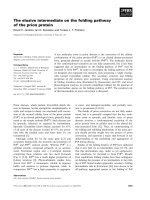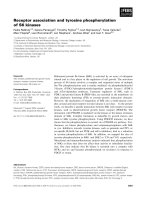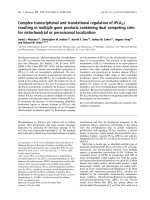báo cáo khoa học: "The hope and the promise of the UN Resolution on non-communicable diseases" potx
Bạn đang xem bản rút gọn của tài liệu. Xem và tải ngay bản đầy đủ của tài liệu tại đây (194.45 KB, 3 trang )
COMM E N T ARY Open Access
The hope and the promise of the UN Resolution
on non-communicable diseases
George Alleyne
1
, David Stuckler
2,3*
, Ala Alwan
4
The hope and the promise of the UN Resolution
on non-communicable diseases
On May 13, 2010, the United Nations General Assembly
passed resolution 2 65, ‘Prevention and control of non-
communicable diseases’[1], a major political statement
calling for Heads of State to address NCDs in a ‘ High
Level’ plenary meeting scheduled for Septembe r 2011.
Out of this meeting, and its associated “outcome docu-
ment”, will come a series of programmatic steps by all
UN members. We cannot understate the potential of
this UN resolution to make chronic non-communicable
diseases (NCDs) a global priority among international
leaders. While in the past there have been numerous
resolutions in the World Health Organization World
Health Assembly for greater action on NCDs, this UN
resolution has special significance, as it comes with the
hope to achieve multisectoral commitment and promise
to deliver change. However, its overall effectiveness will
depend on the ability of the international communi ty to
take advantage of this powerful political opportunity to
institutionalize NCD prevention and control into poli-
cies and programmes within the broader development
agenda. In this editorial we describe the kinds of out-
comes that are possible and needed, and outline strate-
gies for generating global interest as part of a social
movement so to ensure commitment by Heads of State.
Significance of the UN Resolution on Prevention and
Control of Non-Communicable Disease
First, it is important to describe the genesis of the UN
Resolution, because it reflects an unprecedented level of
support for action on NCDs from countries of all regions.
The driving force behind the resolution is the countries of
the Caribbean Community (CARICOM), which, in colla-
boration with other countries, drafted the resolution.
Their work built on two recent, important events: first, the
Doha Declaration, adopted at the Ministerial Me eting on
NCDs and Development, organized by the United Nations
Department of Economic and Social Affairs and WHO in
Doha, Qatar, in May 2009; and second, the subsequent
discussions during the High-Level segment of the United
Nations Social and Economic Council in July 2009, which
recognized that NCDs in developing countries pose a
major threat to development and called for urgent action
to implement the World Health Organization Action Plan
for the Global Strategy for the Prevention and Control of
Non-communicable Diseases. T he U N Resolution is
co-sponsored by 78 countries, as well as Cameroon on
behalf of the African States, including support from all
geographicregionsaswellasrepresentativesoftheG-8
and 16 leading foreign aid donor countries.
Second, in re-framing the global discussion about
NCDs, which often mistakenly focuses o n ‘blaming the
individual’ for unhealthy choices, the UN Resolution
emphasises the underlying social and environmental dri-
vers of NCDs, and their implications for poverty. As the
Resolution notes, “the conditions in which people live
influence their health and quality of life and that the
most prominent non-communicable diseases are linked
to common risk factors [that] have economic, social,
gender, political, behavioural and environmental deter-
minants, and in this regard stressing the need for a mul-
tisectoral response to combat non-communicable
diseases” [1]. Further, the Resolution records the “threat
[NCDs] pose to the economies of Member States, lead-
ing to increasing inequalities between countries and
populatio ns, thereby threatening the achievement of the
internationally agreed de velopment goals, including the
Millennium Development Goals.” This framing places
NCDs as a part of the UN Social Development agenda,
creating space for its inclusion in the Millennium Devel-
opment Goals and the post-Millennium Development
Goal era after 2015.
Third, the Resolution also places chronic diseases at
the centre of other development and health initiatives,
including the need to strengthen health systems, the
* Correspondence:
2
Department of Sociology, Oxford University, Manor Road, Oxford OX1 3UQ,
UK
Full list of author information is available at the end of the article
Alleyne et al. Globalization and Health 2010, 6:15
/>© 2010 Alley ne e t a l; licensee BioM ed Central Ltd. This is an Open Ac cess article dist ributed under t he terms of the Creative Commons
Attribution License ( which permits unrestricted use, di stribution, and reproduction in
any medium, provided the original work is properly cited.
focus on prevention and control of disease, and impor-
tance of whole-of-government approaches to public
health. It also builds on the work undertaken by WHO,
such as the Action Plan for the Global Strategy for the
Prevention and Control of Non-communicable Diseases,
the World H ealth Organization Framework Convention
on Tobacco Control, and the Global Strategy on Diet,
Physical Activity and Health, and the recently endorsed
Global Strategy to Reduce Harmful Use of Alcohol, spe-
cifically “ recognizing the leading role o f the World
Health Organization.”
Three Main Policy Opportunities
Three entry points are created by the Resolution: 1)
there will be a High-level Meeting of the United Nations
General Assembly in September 2011, with participation
of Heads of State and Government; 2) Member States
are invited to speak of the socio-economic impact of
NCDs and the developmental challenges they face at the
MDG Summit in September 2010; and 3) the UN Secre-
tary General will submit a Report on the global status of
the NCDs to the United Nations General Assembly at
its sixty-fifth session which begins in September 2010.
What can realistically be achieved as a result of these
meetings and reports? Some clues are from the out-
comes of past Resolutions. For example, in 2001, the
HIV community held a UN high-level plenary meeting
[2]. It sparked political commitments by Heads of State,
and paved the way for a scale-up of funding and donor
resources for addressing the HIV epidemic. While the
situation facing the NCD community differs, in many
respects it is similar: HIV is a chronic disease; the global
communi tys response to HIV was similarly belated; and,
as with HIV, there is a significant potential, that left
unchecked, NCDs will impose a devastating health bur-
den on p eople and health systems of low-income coun-
tries, much like HIV did throughout the 1980s and
1990s. Another parallel is the UN Diabetes resolution in
2006 [3], which created a World Diabetes Day, a major
rallying point for the diabetes community (albeit a rela-
tively small-scale awareness activity in comparison with
the promise of the current resolution to include NCD
prevention in global development initiatives). In view of
these past successes, there is little doubt that a major
outcome of importance to the glo bal effort to control
NCDs will occur.
What can concerned advocates and experts do now?
To fulfill the promise of the opportunities created by the
UN Resolution, there is a critical window for those con-
cerned about rising NCDs t o act. First, the attention of
Heads of State and Government must be secured to
promote their participation in the meeting in September
2011. Second, while Member States will decide on the
final outcomes of the meeting, international develop-
ment agencies, t he World Bank, UN Agencies, civil
society, and the private sector must provide support
through a consultative process towards the outcome
document. It is hoped that the outcome will include
political commitment to goals and quantifiable targets
that are measured by indicators which are included as
an integral part of global development initiatives. Third,
stakeholders must be rallied around a common vision
and road map to operationalize a global response during
the next decades to come.
While the specific details will emerge from the consulta-
tive process, there are some issues that we believe are
essential to include in the discussions. One is that there is
a need for indicators relevant to the NCDs to be included
as part of global development initiatives. Supporting the
long-standing calls from the developing countries that the
MDGs must take into account the prevention and control
of non-communicable diseases, evidence is emerging that
non-communicable di seases hold back the attainment of
some of the MDGs. One recent study found that a 10 per
cent reduction in rate of deaths from non-communicable
diseases would have a similar impact on accelerating pro-
gress towards the tuberculosis MDG target as a a decade
of economic growth in low-income countries [4]. Addres-
sing NCDs is therefore also essential to achieving existing
goals.
A second issue is national level commitments t o sup-
port the implementation of the WHO A ction Plan of
the Global Strategy for Non-communicable Diseases and
adopt coherent approaches to policy development across
non-health sectors to prevent and control of non-com-
municable diseases. This means explicitly incorporating
NCDs into poverty-reduction strategies and in relevant
social and economic policies. Here, it will be necessary
to adopt whole-of-government approaches to reducing
the common risk factors with priority reference to
tobacco, salt intake, dietary fats, especially transfats
through the most effective policy interventions, includ-
ing national legislation, regulation and taxation.
A third issue is the import ance of extending the com-
mitment to universal access to essential medicines and
technologies, including the secondary prevention of car-
diovascular disease and the treatment of cancers, dia-
betes, and respiratory disease. Preventing and treating
NCDs must be viewed as a component of the health
system strengthening agenda, in view of the inevitability
of the need for long term and coordinated care for the
chronic diseases (whether they are infectious such as
AIDS or non-infectious in origin).
Who gets assigned the task to promote the implemen-
tation of the recommendations to be included in the
outcome document is an important question. The UN
resolution already gives the World Health Organization
Alleyne et al. Globalization and Health 2010, 6:15
/>Page 2 of 3
primacy in this area. WHO will have an important insti-
tutional role in rallying stakeholders, coordinating on
matters where joint action is needed, providing technical
support, and showing accountability. In this respect, it is
crucial that mechanisms are established to provide
countries and WHO with necessary resources to scale
up action to prevent and control NCDs.
Conclusion: A political platform
The UN Resolution provides a platform for the NCD
community to mobilize around. Whether a movement
coalesces around shared interests in response to this
occasion will depend crucially on the steps taken by
advocates, public health leaders, and health policy
experts now. Not simply the domain of medical specia-
lists, their control involves a wide range of disciplines
and ordinary people everywhere. Relevant non-govern-
mental organizations and other c ivil so ciety actors
include the recently established NCD Alliance of the
International Diabetes Federation (IDF), the World
Heart Federation (WHF), the International Union
against Cancer (UICC) and the International Union
against Tuberculosis and Lung Disease. As the knowl-
edge and technical capacity exist to prevent and control
NCDs, the central challenge now facing the NCD move-
ment is political. The established need for action on the
fiscal determinants of NCDs means that opposition
from vested interests will be expected. For example, in
the case of taxation, one opponent is the tobacco indus-
try, which will continue its aggressive marketing and
lobb ying practices. One thing is clear: change will occur
as a result of the UN Resolution. How much this change
will amplify successive efforts to act on the u nderlying
societal causes of NCDs is the principal battle to be
fought.
Author details
1
Pan American Health Organization, 525 23rd Street, N.W., Washington D.C.
20037, USA.
2
Department of Sociology, Oxford University, Manor Road,
Oxford OX1 3UQ, UK.
3
London School of Hygiene & Tropical Medicine,
Department of Public Health Policy, Keppel Street, London WC1E 7HT, UK.
4
World Health Organization, Assistant Director-General, Noncommunicable
Diseases and Mental Health, Avenue Appia 20, 1211 Geneva 27, Switzerland.
Authors’ contributions
GA, DS, and AA contributed to the writing of the manuscript. All authors
have read and approved the final manuscript.
Competing interests
The authors declare that they have no competing interests.
Received: 13 July 2010 Accepted: 9 September 2010
Published: 9 September 2010
References
1. UN: Prevention and control of non-communicable disease. New York:
United Nations 2010 [ />noncommunicable_diseases_20100514/en/index.html].
2. UN: Special session on HIV/AIDS; New York, 25-27 June 2001. United
Nations 2001.
3. UN: 61/225 World Diabetes Day. New York: United Nations 2006 [http://
www.worlddiabetesday.org/the-campaign/unite-for-diabetes/the-un-
resolution-on-diabetes].
4. Stuckler D, Basu S, McKee M: Drivers of Inequality in Millennium
Development Goal Progress: A Statistical Analysis. PLoS Med 2010, 7(3).
doi:10.1186/1744-8603-6-15
Cite this article as: Alleyne et al.: The hope and the promise of the UN
Resolution on non-communicable diseases. Globalization and Health 2010
6:15.
Submit your next manuscript to BioMed Central
and take full advantage of:
• Convenient online submission
• Thorough peer review
• No space constraints or color figure charges
• Immediate publication on acceptance
• Inclusion in PubMed, CAS, Scopus and Google Scholar
• Research which is freely available for redistribution
Submit your manuscript at
www.biomedcentral.com/submit
Alleyne et al. Globalization and Health 2010, 6:15
/>Page 3 of 3









